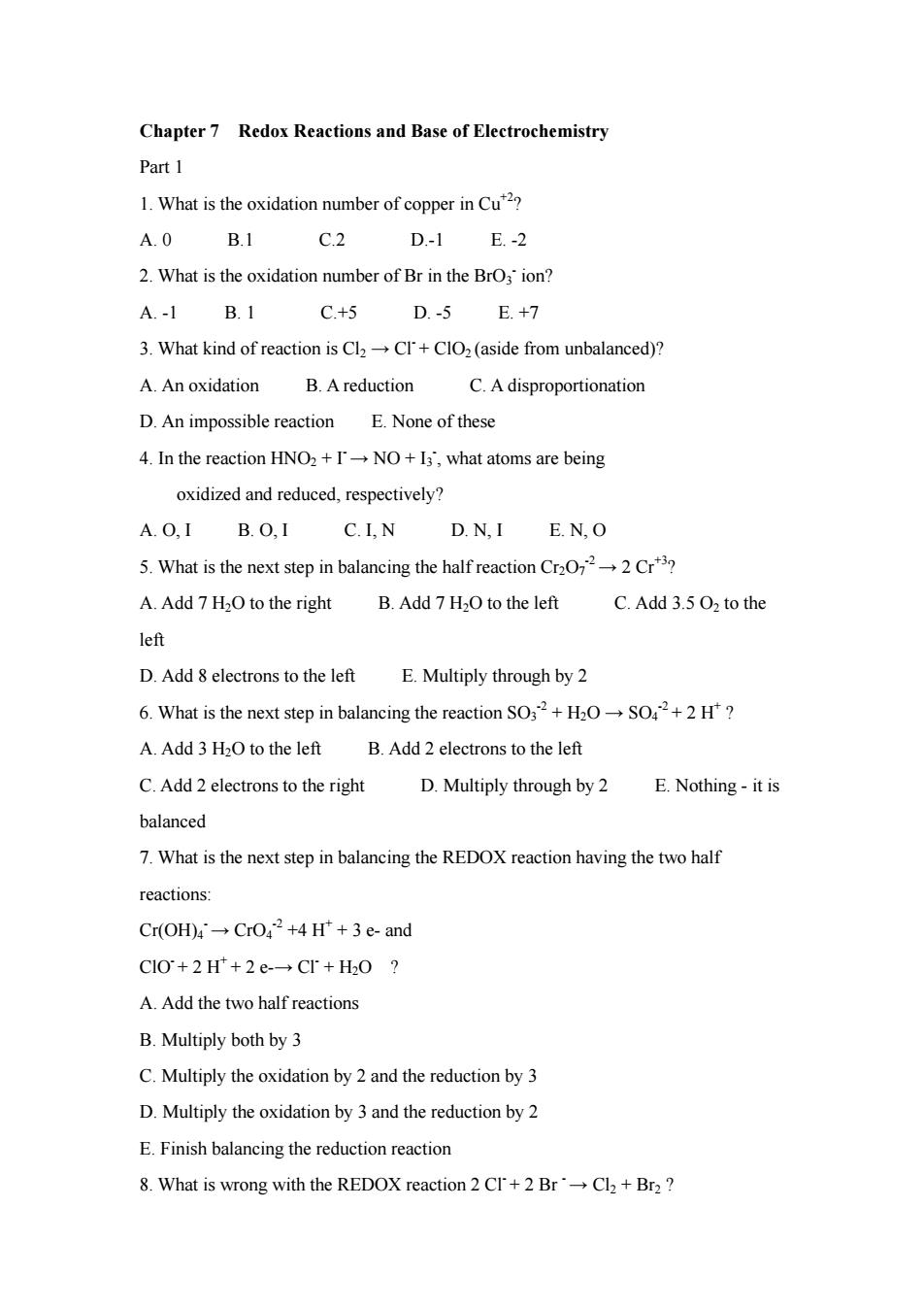
Chapter 7 Redox Reactions and Base of Electrochemistry Part 1 1.What is the oxidation number of copper in Cu A.0 B.1 C.2 D-1 E.-2 2.What is the oxidation number of Br in the BrO3 ion? A.-1B.1 C.+5D.-5E.+7 3.What kind of reaction is ClC+CIO2(aside from unbalanced)? A.An oxidation B.Areduction C.A disproportionation D.An impossible reaction E.None of these 4.In the reaction HNO2+NO+,what atoms are being oxidized and reduced,respectively? A.0,1B.0,1 C.I,N D.N,I E.N,O 5.What is the next step in balancing the half reaction Cr2OCr A.Add 7 H2O to the right B.Add 7 H2O to the left C.Add 3.5 O2 to the left D.Add 8 electrons to the left E.Multiply through by 2 6.What is the next step in balancing the reaction SO3+H2OSO+2H? A.Add 3 H2O to the left B.Add2 electrons to the left C.Add 2 electrons to the right D.Multiply through by 2 E.Nothing-it is balanced 7.What is the next step in balancing the REDOX reaction having the two half reactions Cr(OH)CrO2+4 H*+3 e-and CIO+2H+2e-→Cr+H0? A.Add the two half reactions B.Multiply both by 3 C.Multiply the oxidation by 2 and the reduction by3 D.Multiply the oxidation by 3 and the reduction by 2 E.Finish balancing the reduction reaction 8.What is wrong with the REDOX reaction 2 CI+2+Br2?
Chapter 7 Redox Reactions and Base of Electrochemistry Part 1 1. What is the oxidation number of copper in Cu+2? A. 0 B.1 C.2 D.-1 E. -2 2. What is the oxidation number of Br in the BrO3 - ion? A. -1 B. 1 C.+5 D. -5 E. +7 3. What kind of reaction is Cl2 → Cl- + ClO2 (aside from unbalanced)? A. An oxidation B. A reduction C. A disproportionation D. An impossible reaction E. None of these 4. In the reaction HNO2 + I- → NO + I3 - , what atoms are being oxidized and reduced, respectively? A. O, I B. O, I C. I, N D. N, I E. N, O 5. What is the next step in balancing the half reaction Cr2O7 -2 → 2 Cr+3? A. Add 7 H2O to the right B. Add 7 H2O to the left C. Add 3.5 O2 to the left D. Add 8 electrons to the left E. Multiply through by 2 6. What is the next step in balancing the reaction SO3 -2 + H2O → SO4 -2 + 2 H+ ? A. Add 3 H2O to the left B. Add 2 electrons to the left C. Add 2 electrons to the right D. Multiply through by 2 E. Nothing - it is balanced 7. What is the next step in balancing the REDOX reaction having the two half reactions: Cr(OH)4 - → CrO4 -2 +4 H+ + 3 e- and ClO- + 2 H+ + 2 e-→ Cl- + H2O ? A. Add the two half reactions B. Multiply both by 3 C. Multiply the oxidation by 2 and the reduction by 3 D. Multiply the oxidation by 3 and the reduction by 2 E. Finish balancing the reduction reaction 8. What is wrong with the REDOX reaction 2 Cl- + 2 Br - → Cl2 + Br2 ? 1

A.Nothing B.Nothing is being oxidized C.Nothing is being reduced D.Chloride can not be oxidized E.Bromide can not be oxidized 9.When the balanced reaction 2 MnO4+SO32+H2O-2 MnO4+SO4-2+2 H' is changed to be balanced in basic solution,the result is A2MnO,+S032-2Mn0,2+S02+H20 B.2Mn0:+S032+2Or→2Mn0:2+S0.2+H0 C.2 MnO+S032-2 MnO42+S02+H2O+2 OH D.2Mn04+S032+H0-→2Mn042+S04-2+2H+2OH E.2MnO4+S032+2OH→2Mn042+S0,2+H20+2OH 10.What are the oxidation numbers of the V,Oand Cl atoms in VOCl3? A-5,-2-1 B.5,+2,1 C.+5,-2,+1 D.+4,-1,-1 E.+5,-2,-1 11.A Galvanic cell: A.Has a spontaneous chemical reaction B.Has a positive cell potential C.Has a negatively charge anode D.All of the above E.None of the above 12.An electrolytic cell A.Has a non-spontaneous chemical reaction B.Requires application of a negative potential to make the reaction occur C.Has a positively charged anode D.All of the above E.None of the above 13.In a galvanic cell: A.Electrons flow from the cathode to the anode via the external circuit B.Electrons lose some of their energy in the external circuit
A. Nothing B. Nothing is being oxidized C. Nothing is being reduced D. Chloride can not be oxidized E. Bromide can not be oxidized 9. When the balanced reaction 2 MnO4 - + SO3 -2 + H2O → 2 MnO4 -2 + SO4- 2 + 2 H+ is changed to be balanced in basic solution, the result is: A. 2 MnO4 - + SO3 -2 → 2 MnO4 -2 + SO4 -2 + H2O B. 2 MnO4 - + SO3 -2 + 2 OH- → 2 MnO4 -2 + SO4 -2 + H2O C. 2 MnO4 - + SO3 -2 → 2 MnO4 -2 + SO4 -2 + H2O + 2 OH- D. 2 MnO4 - + SO3 -2 + H2O →2 MnO4 -2 + SO4- 2 + 2 H+ + 2 OH- E. 2 MnO4 - + SO3 -2 + 2 OH- → 2 MnO4 -2 + SO4 -2 + H2O + 2 OH- 10. What are the oxidation numbers of the V, O and Cl atoms in VOCl3? A. -5, -2, -1 B. -5, +2, -1 C. +5, -2, +1 D. +4, -1, -1 E. +5, -2, -1 11. A Galvanic cell: A. Has a spontaneous chemical reaction B. Has a positive cell potential C. Has a negatively charge anode D. All of the above E. None of the above 12. An electrolytic cell: A. Has a non-spontaneous chemical reaction B. Requires application of a negative potential to make the reaction occur C. Has a positively charged anode D. All of the above E. None of the above 13. In a galvanic cell: A. Electrons flow from the cathode to the anode via the external circuit B. Electrons lose some of their energy in the external circuit 2
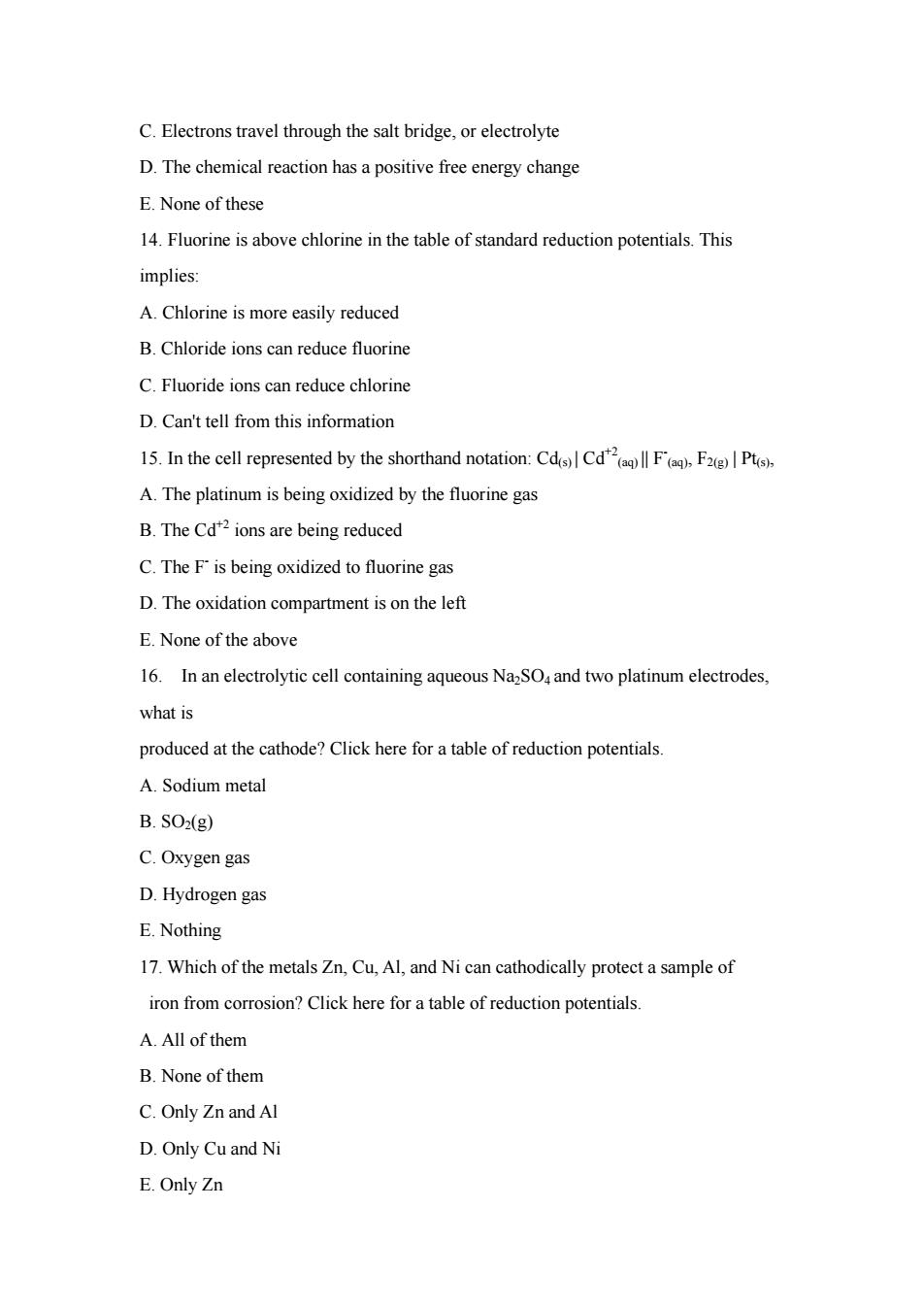
C.Electrons travel through the salt bridge,or electrolyte D.The chemical reaction has a positive free energy change E.None of these 14.Fluorine is above chlorine in the table of standard reduction potentials.This implies: A.Chlorine is more easily reduced B.Chloride ions can reduce fluorine C.Fluoride ions can reduce chlorine D.Can't tell from this information 15.In the cell represented by the shorthand notation:CdCd FF P A.The platinum is being oxidized by the fluorine gas B.The Cd2ions are being reduced C.The F"is being oxidized to fluorine gas D.The oxidation compartment is on the left E.None of the above 16.In an electrolytic cell containing aqueous NaSOand two platinum electrodes, what is produced at the cathode?Click here for a table of reduction potentials A.Sodium metal B.S02(g) C.Oxygen gas D.Hydrogen gas E.Nothing 17.Which of the metals Zn,Cu,Al,and Ni can cathodically protect a sample of iron from corrosion?Click here for a table of reduction potentials. A.All of them B.None of them C.Only Zn and Al D.Only Cu and N E.Only Zn
C. Electrons travel through the salt bridge, or electrolyte D. The chemical reaction has a positive free energy change E. None of these 14. Fluorine is above chlorine in the table of standard reduction potentials. This implies: A. Chlorine is more easily reduced B. Chloride ions can reduce fluorine C. Fluoride ions can reduce chlorine D. Can't tell from this information 15. In the cell represented by the shorthand notation: Cd(s) | Cd+2 (aq) || F- (aq), F2(g) | Pt(s), A. The platinum is being oxidized by the fluorine gas B. The Cd+2 ions are being reduced C. The F- is being oxidized to fluorine gas D. The oxidation compartment is on the left E. None of the above 16. In an electrolytic cell containing aqueous Na2SO4 and two platinum electrodes, what is produced at the cathode? Click here for a table of reduction potentials. A. Sodium metal B. SO2(g) C. Oxygen gas D. Hydrogen gas E. Nothing 17. Which of the metals Zn, Cu, Al, and Ni can cathodically protect a sample of iron from corrosion? Click here for a table of reduction potentials. A. All of them B. None of them C. Only Zn and Al D. Only Cu and Ni E. Only Zn 3
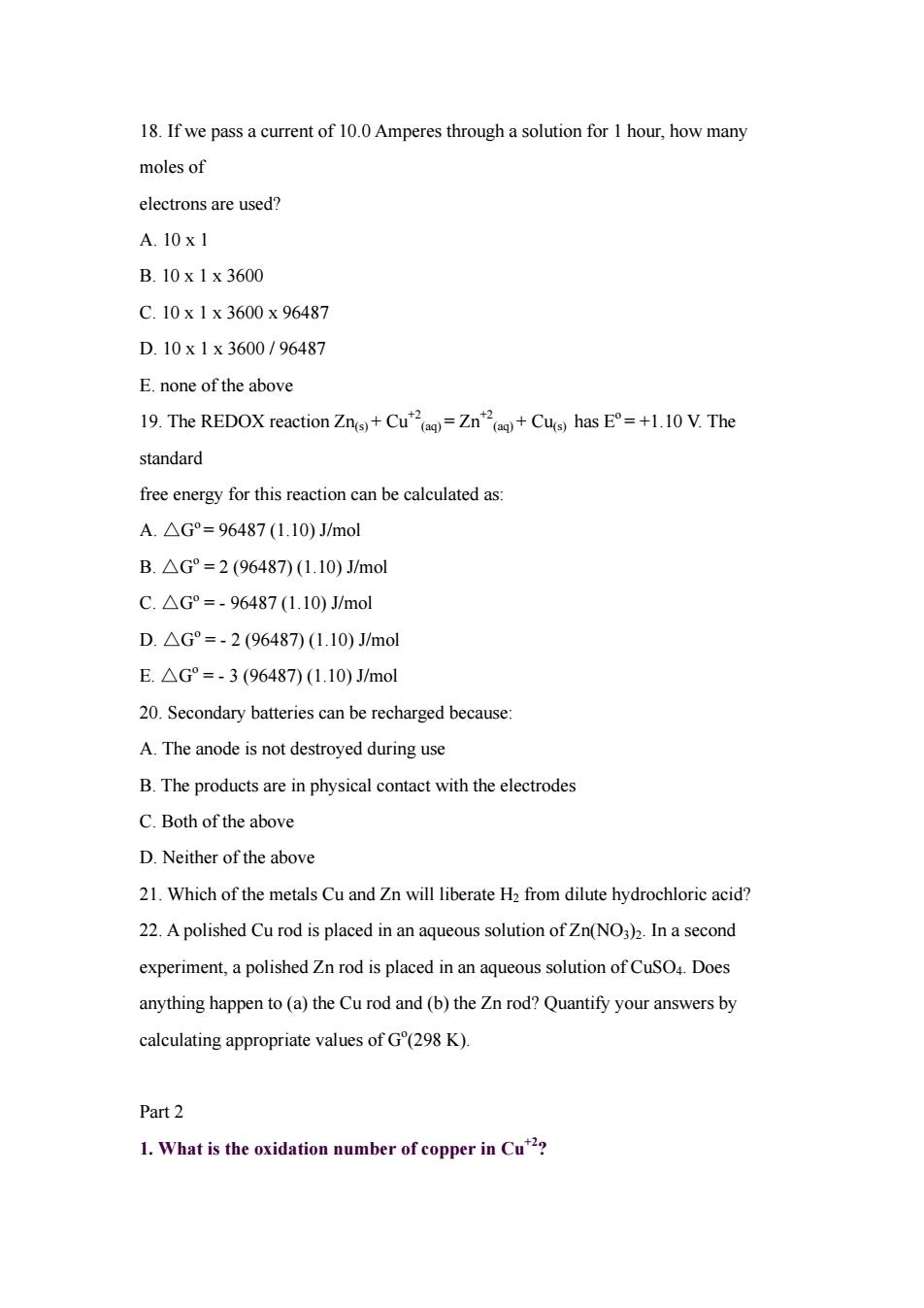
18.If we pass a current of 10.0 Amperes through a solution for 1 hour,how many moles of electrons are used? A.10x1 B.10x1x3600 C.10x1x3600x96487 D.10x1x3600/96487 E.none of the above 19.The REDOX reaction Zn(s)+Cu"(=Zn()+Cu(s)has E=+1.10 V.The standard free energy for this reaction can be calculated as A.△G°=96487(1.10)J/mol B.△G°=2(96487)(1.10)J/mol C.△G°=.96487(1.10)J/mol D.△G°=-2(96487)(1.10)J/mol E.△G°=-3(96487(1.10)J/mol 20.Secondary batteries can be recharged because A.The anode is not destroyed during use B.The products are in physical contact with the electrodes C.Both of the above D.Neither of the above 21.Which of the metals CuandZn will liberate H2 from dilute hydrochloric acid? 22.Apolished Cu rod is placed in an aqueous solution ofZn(NO).In a second experiment,a polished Zn rod is placed in an aqueous solution of CuSO.Does anything happen to(a)the Cu rod and(b)the Zn rod?Quantify your answers by calculating appropriate values of G(298 K). Part2 1.What is the oxidation number of copper in Cu?
18. If we pass a current of 10.0 Amperes through a solution for 1 hour, how many moles of electrons are used? A. 10 x 1 B. 10 x 1 x 3600 C. 10 x 1 x 3600 x 96487 D. 10 x 1 x 3600 / 96487 E. none of the above 19. The REDOX reaction Zn(s) + Cu+2 (aq) = Zn+2 (aq) + Cu(s) has Eo = +1.10 V. The standard free energy for this reaction can be calculated as: A. G △ o = 96487 (1.10) J/mol B. G △ o = 2 (96487) (1.10) J/mol C. G △ o = - 96487 (1.10) J/mol D. G △ o = - 2 (96487) (1.10) J/mol E. G △ o = - 3 (96487) (1.10) J/mol 20. Secondary batteries can be recharged because: A. The anode is not destroyed during use B. The products are in physical contact with the electrodes C. Both of the above D. Neither of the above 21. Which of the metals Cu and Zn will liberate H2 from dilute hydrochloric acid? 22. A polished Cu rod is placed in an aqueous solution of Zn(NO3)2. In a second experiment, a polished Zn rod is placed in an aqueous solution of CuSO4. Does anything happen to (a) the Cu rod and (b) the Zn rod? Quantify your answers by calculating appropriate values of Go (298 K). Part 2 1. What is the oxidation number of copper in Cu+2? 4
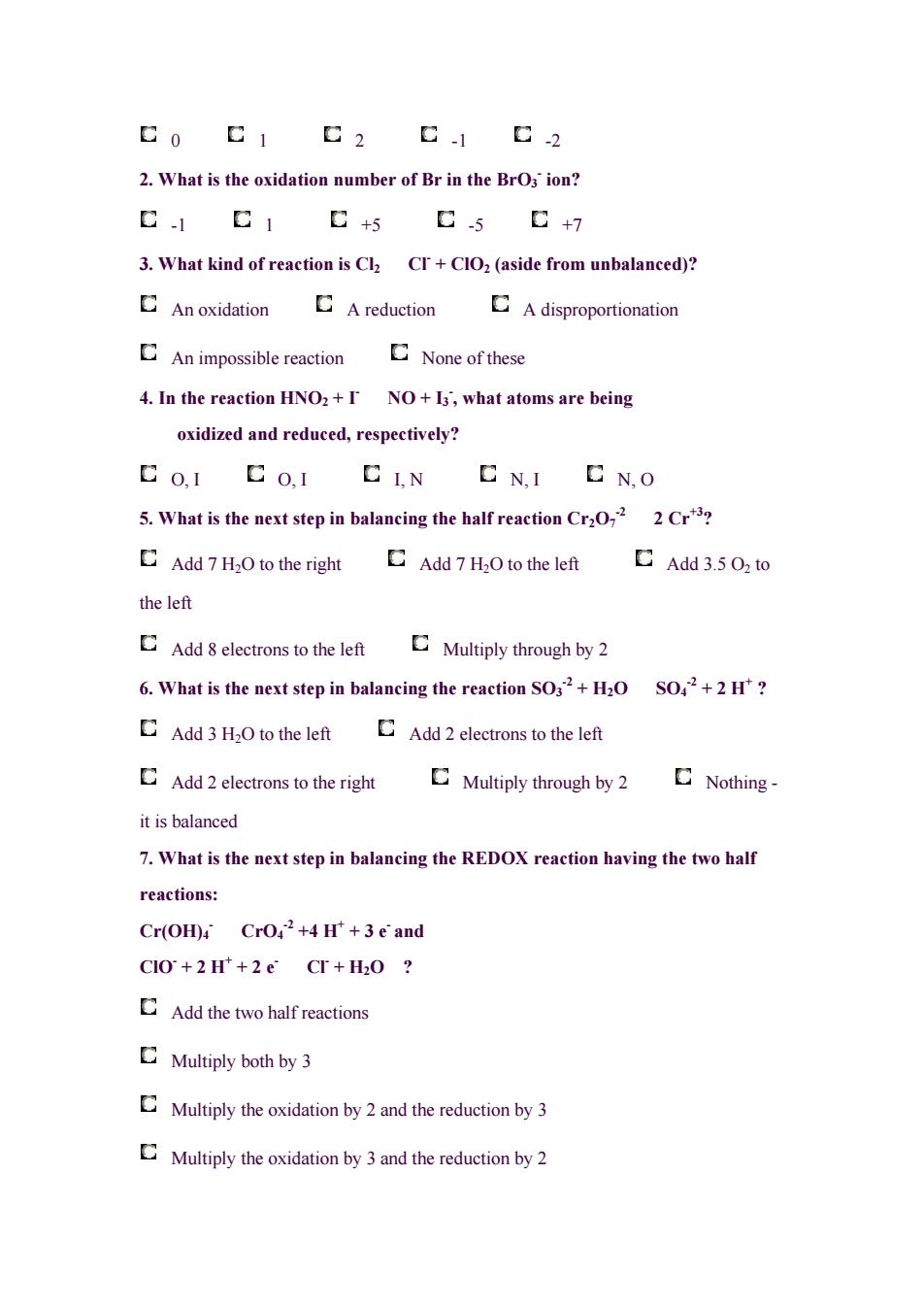
0001020102 2.What is the oxidation number of Br in the BrOs'ion? -1010+5050+7 3.What kind of reaction is Cl Cr+CIO2(aside from unbalanced)? An oxidation A reduction A disproportionation An impossible reaction None ofthese 4.In the reaction HNO2+I NO+I3,what atoms are being oxidized and reduced,respectively? C o.I 5.What is the next step in balancing the half reaction Cr2O,2 2 Cr3? Add7Hto the right Add7Hto the left Add 35:to the left Addeetrons to the leftMultiply through by2 6.What is the next step in balancing the reaction SO3+H2O SO+2H'? Add3Hto the leftAdd 2 electrons to the let Add2 electrons to the right Multiply through by 2 Nothing it is balanced 7.What is the next step in balancing the REDOX reaction having the two half reactions: Cr(OH)CrO2+4H+3 eand CIO+2H+2eCr+H20? Add the two half reactions Multiply both by3 Multiply the xiatio byand theeduction by3 Muipy the oxidation by3and the reduction by
0 1 2 -1 -2 2. What is the oxidation number of Br in the BrO3 - ion? -1 1 +5 -5 +7 3. What kind of reaction is Cl2 Cl - + ClO2 (aside from unbalanced)? An oxidation A reduction A disproportionation An impossible reaction None of these 4. In the reaction HNO2 + I- NO + I 3 - , what atoms are being oxidized and reduced, respectively? O, I O, I I, N N, I N, O 5. What is the next step in balancing the half reaction Cr2O7 -2 2 Cr +3? Add 7 H2O to the right Add 7 H2O to the left Add 3.5 O2 to the left Add 8 electrons to the left Multiply through by 2 6. What is the next step in balancing the reaction SO3 -2 + H2O SO 4 -2 + 2 H+ ? Add 3 H2O to the left Add 2 electrons to the left Add 2 electrons to the right Multiply through by 2 Nothing - it is balanced 7. What is the next step in balancing the REDOX reaction having the two half reactions: Cr(OH)4 - CrO4 -2 +4 H+ + 3 e- and ClO- + 2 H+ + 2 e- Cl - + H2O ? Add the two half reactions Multiply both by 3 Multiply the oxidation by 2 and the reduction by 3 Multiply the oxidation by 3 and the reduction by 2 5
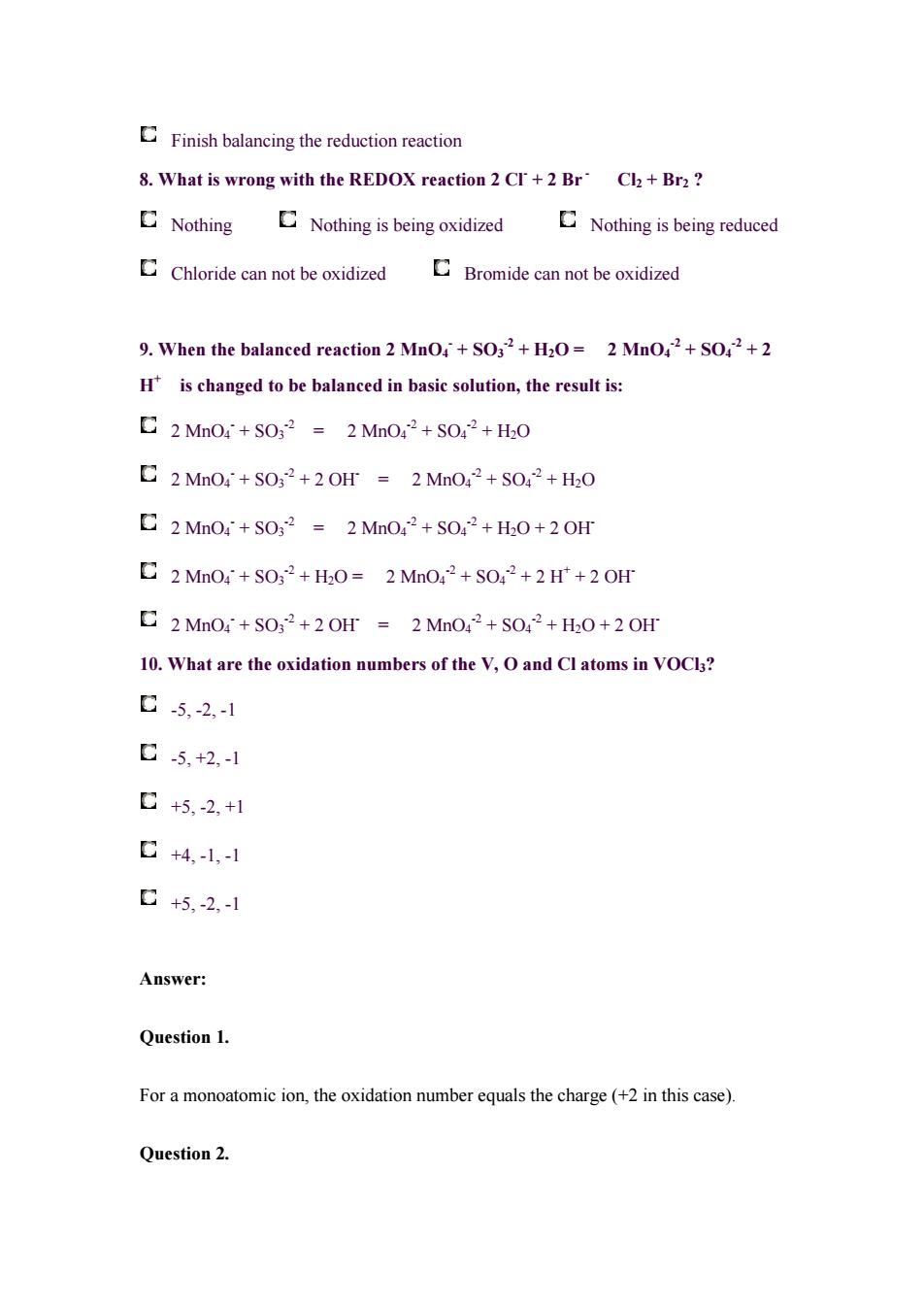
Finish balancing the reduction reaction 8.What is wrong with the REDOX reaction 2 Cr+2 Br'Cl+Br2 Nothing Nothing is being oxidizd Nothing is being redueed Chloride cn not be oxidized Bromide can not be oxidize 9.When the balanced reaction 2 MnO+SOs+H2O=2 MnO2+O2+2 H'is changed to be balanced in basic solution,the result is: C2Mn0s+S0,2=2Mn0:2+S0:2+H0 C2Mn0+S02+20H=2Mn02+S0,2+H0 C2Mn0:+S02=2Mn0:2+S0:2+H0+20H C2Mn0r+S0,2+H0=2Mn0,2+s0,2+2H+20F C2Mn04+s02+20H=2Mn02+S042+H0+20H 10.What are the oxidation numbers of the V,O and Cl atoms in VOCls? 口5,2,1 口-5,+2,1 口+5,2+1 C+4,-1,-1 口+5,2,1 Answer: Question 1. For a monoatomic ion,the oxidation number equals the charge (+2 in this case). Question 2
Finish balancing the reduction reaction 8. What is wrong with the REDOX reaction 2 Cl- + 2 Br - Cl 2 + Br2 ? Nothing Nothing is being oxidized Nothing is being reduced Chloride can not be oxidized Bromide can not be oxidized 9. When the balanced reaction 2 MnO4 - + SO3 -2 + H2O = 2 MnO 4 -2 + SO4 -2 + 2 H+ is changed to be balanced in basic solution, the result is: 2 MnO4 - + SO3 -2 = 2 MnO4 -2 + SO4 -2 + H2O 2 MnO4 - + SO3 -2 + 2 OH- = 2 MnO4 -2 + SO4 -2 + H2O 2 MnO4 - + SO3 -2 = 2 MnO4 -2 + SO4 -2 + H2O + 2 OH- 2 MnO4 - + SO3 -2 + H2O = 2 MnO4 -2 + SO4 -2 + 2 H+ + 2 OH- 2 MnO4 - + SO3 -2 + 2 OH- = 2 MnO4 -2 + SO4 -2 + H2O + 2 OH- 10. What are the oxidation numbers of the V, O and Cl atoms in VOCl3? -5, -2, -1 -5, +2, -1 +5, -2, +1 +4, -1, -1 +5, -2, -1 Answer: Question 1. For a monoatomic ion, the oxidation number equals the charge (+2 in this case). Question 2. 6
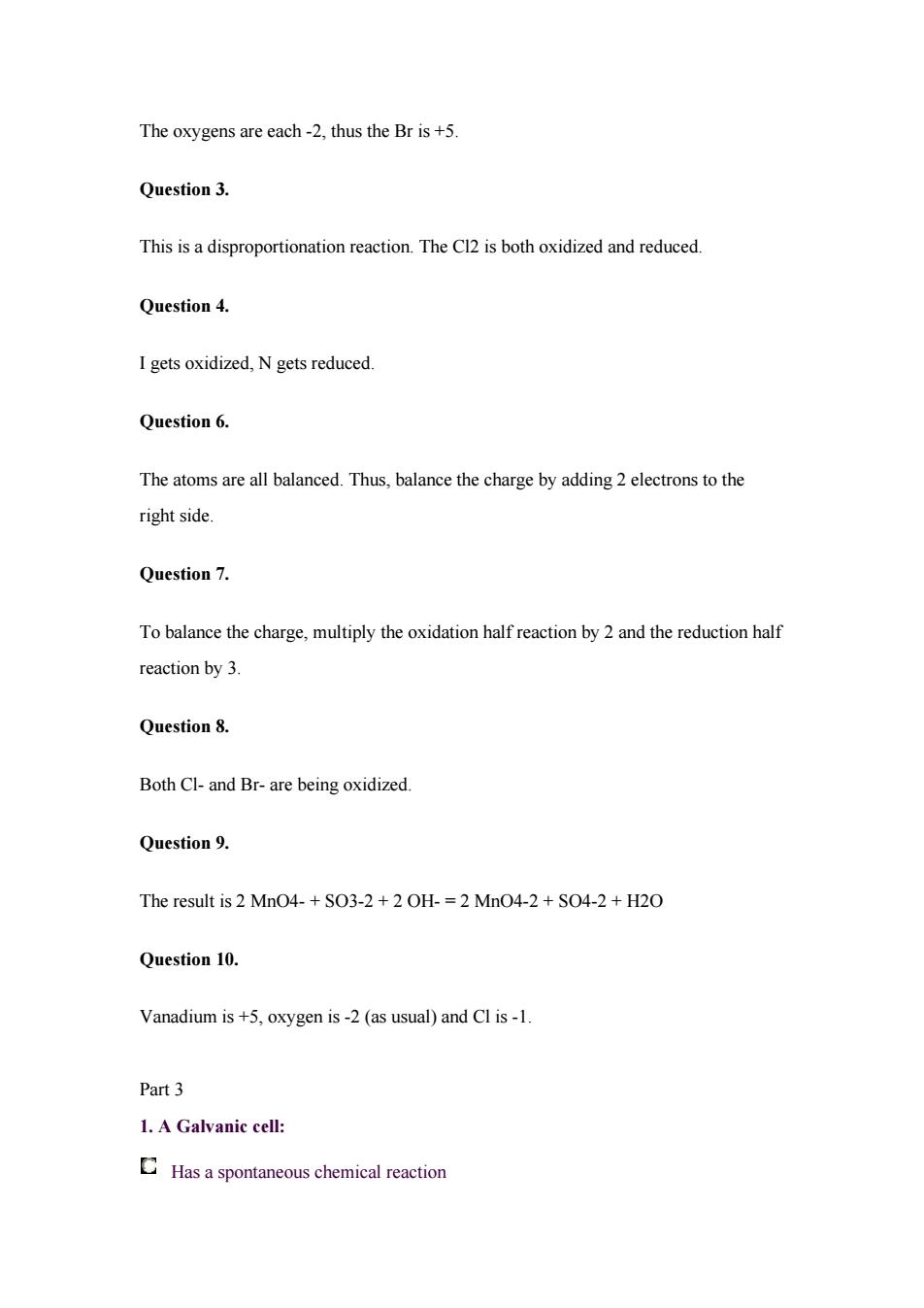
The oxygens are each-2,thus the Br is+5. Question 3. This is a disproportionation reaction.The C12 is both oxidized and reduced. Question 4. I gets oxidized,Ngets reduced Question 6. The atoms are all balanced.Thus,balance the charge by adding 2 electrons to the right side. Question 7. To balance the charge,multiply the oxidation half reaction by 2 and the reduction half reaction by 3. Question 8. Both Cl-and Br-are being oxidized Question9. The result is 2 Mn04-+SO3-2 +2 OH-=2 Mn04-2+S04-2 H20 Question 10. Vanadium is+5,oxygen is-2(as usual)and Cl is-1. Part3 1.A Galvanic cell: chemicalreaction
The oxygens are each -2, thus the Br is +5. Question 3. This is a disproportionation reaction. The Cl2 is both oxidized and reduced. Question 4. I gets oxidized, N gets reduced. Question 6. The atoms are all balanced. Thus, balance the charge by adding 2 electrons to the right side. Question 7. To balance the charge, multiply the oxidation half reaction by 2 and the reduction half reaction by 3. Question 8. Both Cl- and Br- are being oxidized. Question 9. The result is 2 MnO4- + SO3-2 + 2 OH- = 2 MnO4-2 + SO4-2 + H2O Question 10. Vanadium is +5, oxygen is -2 (as usual) and Cl is -1. Part 3 1. A Galvanic cell: Has a spontaneous chemical reaction 7
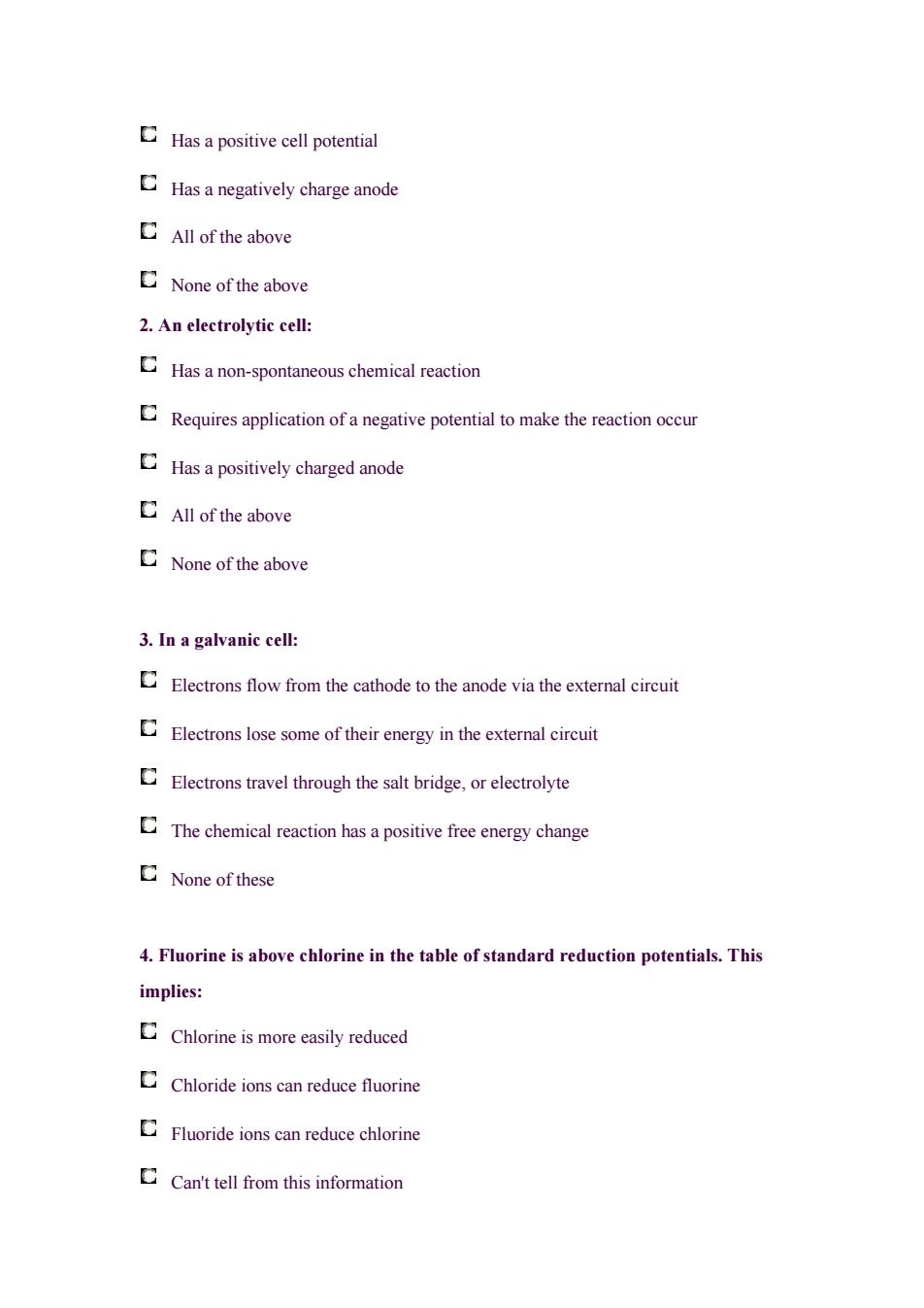
Hasa positive celpotentia Has a negatively charge anode All of the above None of the above 2.An electrolytic cell: Hasaon-ontaoushemical reaction Requires applicationofegive potential to make the reactioncu Has a positively charged anode All of the above None of the above 3.In a galvanic cell: Electronsowfrom the cahodeto the anode viathe exteal ircuit Eectrososem oftheir ry in the exteral eircuit The chemical reaction has a positive free energy change CNone of these 4.Fluorine is above chlorine in the table of standard reduction potentials.This implies: Chlorine is more easily reduced Chloride ion nreduce Fluoride ions can reduce chlorine Can't tell from this information
Has a positive cell potential Has a negatively charge anode All of the above None of the above 2. An electrolytic cell: Has a non-spontaneous chemical reaction Requires application of a negative potential to make the reaction occur Has a positively charged anode All of the above None of the above 3. In a galvanic cell: Electrons flow from the cathode to the anode via the external circuit Electrons lose some of their energy in the external circuit Electrons travel through the salt bridge, or electrolyte The chemical reaction has a positive free energy change None of these 4. Fluorine is above chlorine in the table of standard reduction potentials. This implies: Chlorine is more easily reduced Chloride ions can reduce fluorine Fluoride ions can reduce chlorine Can't tell from this information 8
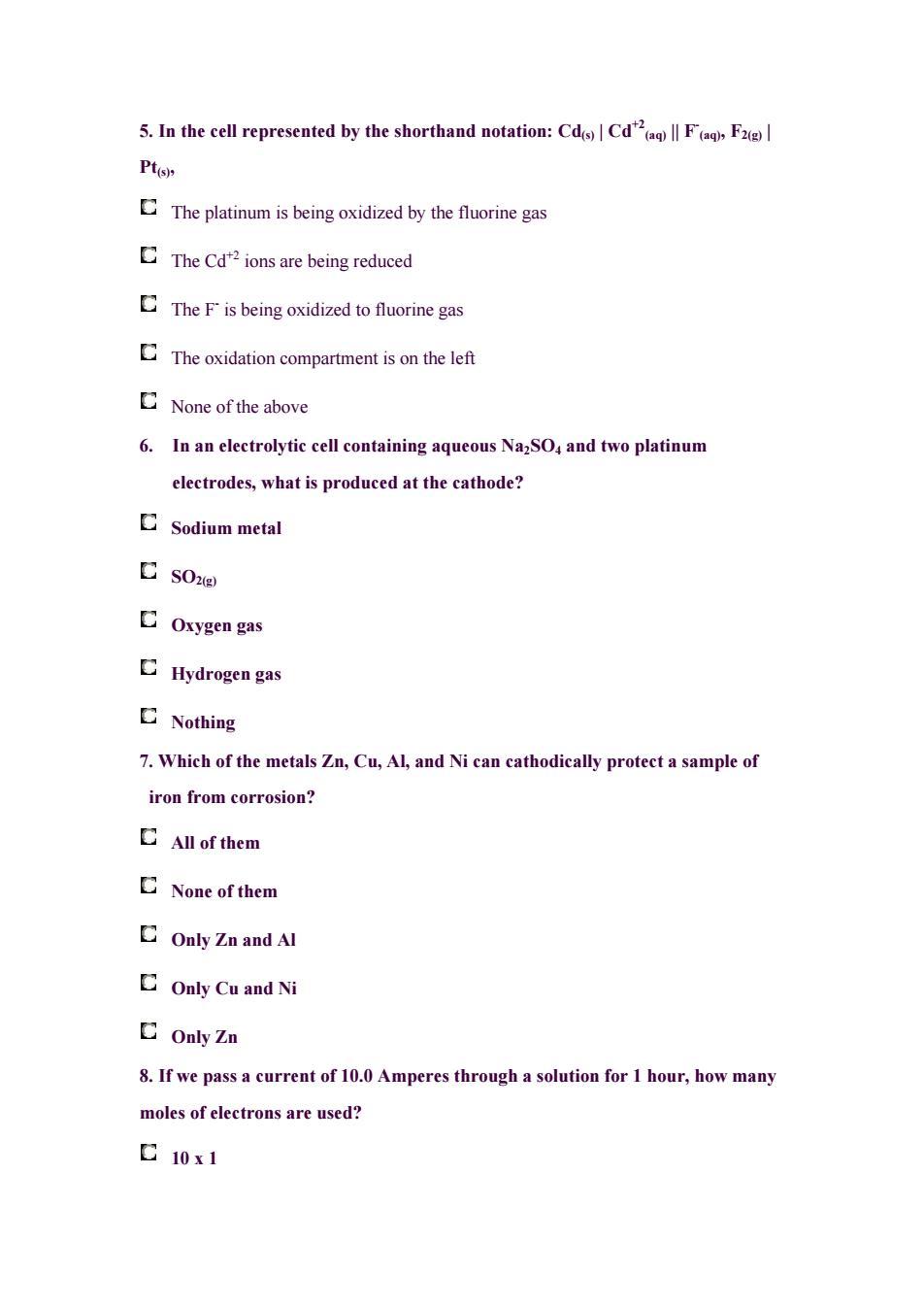
5.In the cell represented by the shorthand notation:CdCdF Ptr The platinum is being oxidized by the fluorine gas The are being reduced Theisbeing gas The oxidation compartment is on the left None of the above 6.In an electrolytic cell containing aqueous NazSO,and two platinum electrodes,what is produced at the cathode? CSodium metal 口S02e C Oxygen gas CHydrogen gas CNothing 7.Which of the metals Zn,Cu,Al,and Ni can cathodically protect a sample of iron from corrosion? CAll of them C None of them COnly Zn and Al COnly Cu and Ni C Only Zn 8.If we pass a current of 10.0 Amperes through a solution for 1 hour,how many moles of electrons are used? C10x1
5. In the cell represented by the shorthand notation: Cd(s) | Cd+2 (aq) || F- (aq), F2(g) | Pt(s), The platinum is being oxidized by the fluorine gas The Cd+2 ions are being reduced The F- is being oxidized to fluorine gas The oxidation compartment is on the left None of the above 6. In an electrolytic cell containing aqueous Na2SO4 and two platinum electrodes, what is produced at the cathode? Sodium metal SO2(g) Oxygen gas Hydrogen gas Nothing 7. Which of the metals Zn, Cu, Al, and Ni can cathodically protect a sample of iron from corrosion? All of them None of them Only Zn and Al Only Cu and Ni Only Zn 8. If we pass a current of 10.0 Amperes through a solution for 1 hour, how many moles of electrons are used? 10 x 1 9
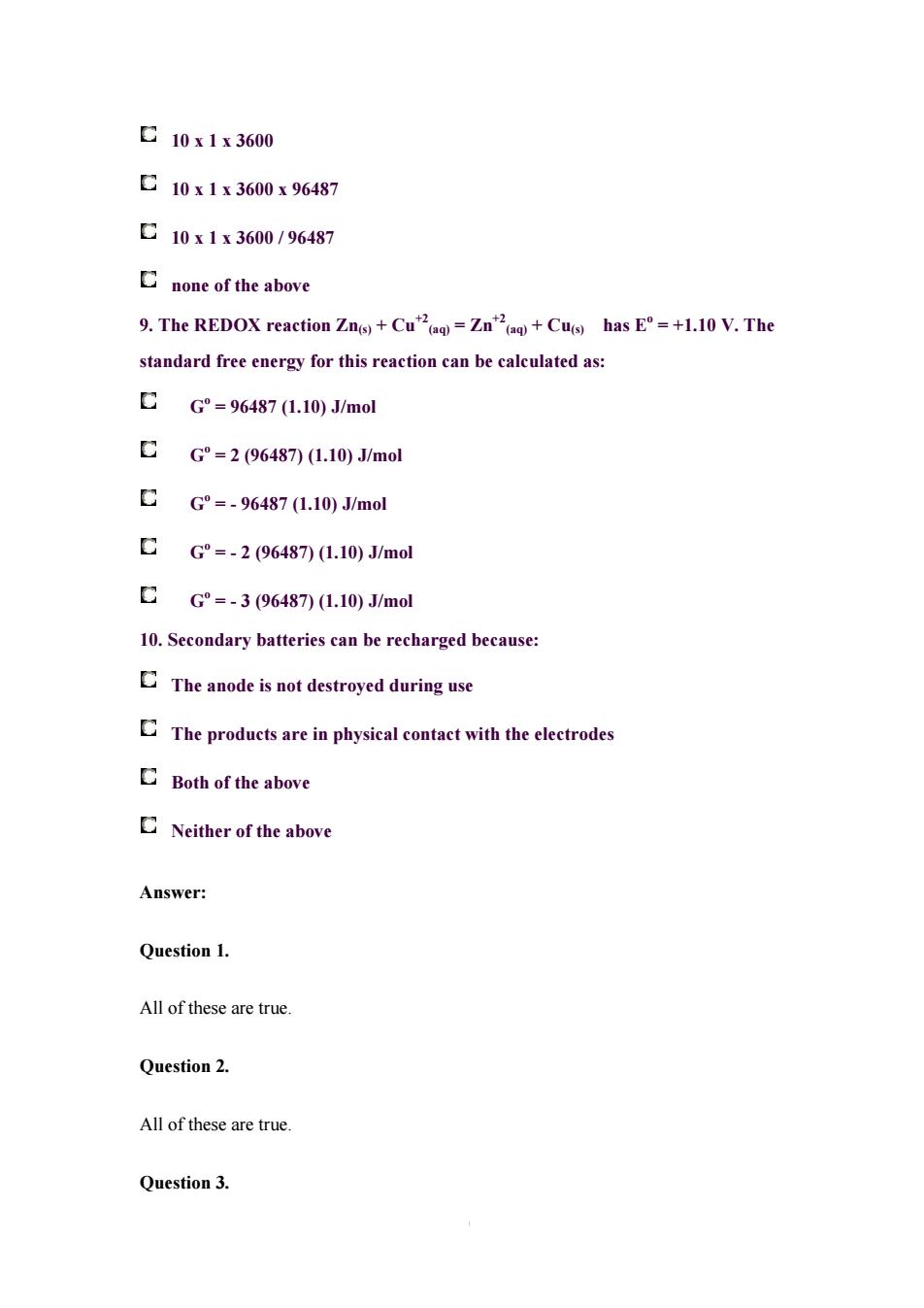
C10x1x3600 C10x1x3600x96487 10x1x3600/96487 none of the above 9.The REDOX reaction Zn)+Cu2a=Zn+Cus has E=+1.10 V.The standard free energy for this reaction can be calculated as: G°=96487(1.10)J/mol CG°=2(96487(1.10)J/mol CG°=.96487(1.10)J/mol G°=-2(96487)(1.10)J/mol CG°=-3(96487(1.10Jmol 10.Secondary batteries can be recharged because: The anode iso destroyed during use The produets are in physical contact with the electrodes CBoth of the above Neither of the above Answer: Question 1. All of these are true Question 2. All of these are true Question 3
10 x 1 x 3600 10 x 1 x 3600 x 96487 10 x 1 x 3600 / 96487 none of the above 9. The REDOX reaction Zn(s) + Cu+2 (aq) = Zn+2 (aq) + Cu(s) has Eo = +1.10 V. The standard free energy for this reaction can be calculated as: Go = 96487 (1.10) J/mol Go = 2 (96487) (1.10) J/mol Go = - 96487 (1.10) J/mol Go = - 2 (96487) (1.10) J/mol Go = - 3 (96487) (1.10) J/mol 10. Secondary batteries can be recharged because: The anode is not destroyed during use The products are in physical contact with the electrodes Both of the above Neither of the above Answer: Question 1. All of these are true. Question 2. All of these are true. Question 3. 10